Advantages of Python: Versatile Software Development Tool

Python is one of those unique programming languages that demonstrate an amazing ability to remain in demand in an ever-changing digital space. For 3 decades now, Python, created in 1991, has consistently been in the top three most popular programming languages among developers. During this time, Python was recognized as the language of the year according to the authoritative TIOBE Index three times. And as if that weren’t enough, in 2020, Python surpassed the seemingly unattainable Java in popularity, becoming the most popular language of the year.
How does Python manage to remain in demand at a time when new languages come and go, and the positions of established leaders are so volatile? What is the secret of Python’s popularity among developers? Today, we will answer these questions and compare Python with other popular languages that are often recorded in its competitors. We will also figure out what advantages and disadvantages Python has and what trends can be observed in the near future.
Investigating Python
In general, Python has the same set of features and qualities as any other popular programming language. Nevertheless, speaking of Python, you can easily distinguish several main features that are the basis of this language.
- Python is multipurpose. It is very difficult to single out some kind of the main area of Pythonapplication since this language is used by developers to solve any problems where there are lines of code and mathematics. So, Python capabilities cover areas such as web applications, Data Science and Big Data tasks, Databases creation, prototypes development, test scripts writing, and so on. In recent years, Python has gained a new influx of popularity after it became clear that it is one of the best languages for computing Big Data tasks.
- Python is relatively simple. That is, perhaps, one of the main features of Python. Unlike other languages like Java and C++, Python uses clear, simple, English-based syntax. It is not for nothing that this language is considered one of the best for novice programmers – the first working program can be written in 2-3 days after the start of training. Python’s simplicity serves not only beginners but also experienced developers. So, it is quite easy for a new member of the development team to understand the finished code of a program written in Python. There are many different sources for learning Python from scratch, and a large and active community will always help with solving complex problems.
- Python is interpreted. Simply put, before running, Python code is a simple text file. This allows programming on almost any platform. The interpreter reads the lines of code one by one, doing what it says. This eliminates the need to compile the code, but it is also the reason why Python is considered too slow for really large and complex tasks. Although this issue is still controversial today.
- OOP. Python’s object-oriented nature allows developers to think about and write code in terms of classes and objects. Going forward, these objects are combined with resources from off-the-shelf Python libraries to create truly complex applications.
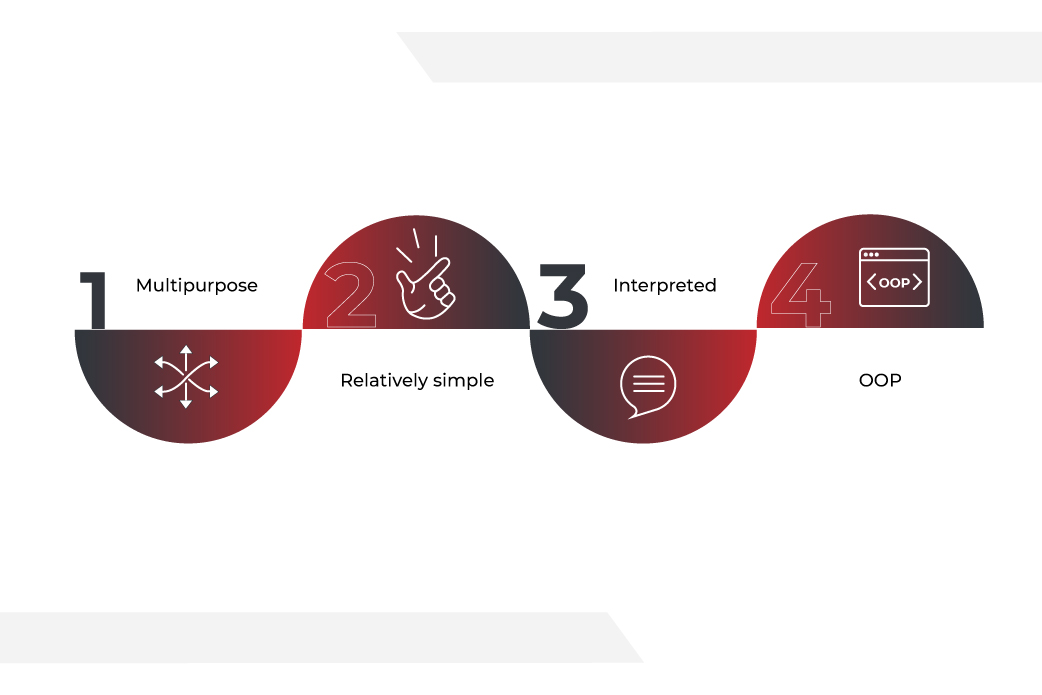
These are the foundations of Python that allow it to be applicable to almost any task a modern developer might face. That said, let’s define a few major areas in which Python is being used.
What can Python be used for?
As we mentioned above, Python is a versatile language that is used for a wide variety of tasks. This versatility is achieved primarily due to the presence of a large number of libraries created to solve specific problems. Some of the most popular libraries include Pandas, TensorFlow, SciPy, and NumPy. The latter is often used to solve AI and Big Data challenges. So what is Python used for?
AI and Machine Learning projects
The growth in opportunities offered by technologies such as AI and Machine Learning is no longer a surprise to anyone. In turn, Python is one of the best languages for creating AI-powered software. This is achieved due to the presence of a large number of libraries and frameworks, sharpened to solve specific problems associated with the designated tasks. Among the most famous libraries, you can recall a few of those that we mentioned above, adding Keras and Pytorch. All of these libraries have extensive tools for creating AI and Machine Learning projects. The simplicity of Python’s code also helps developers not get distracted by complex syntax and devote all their time to creating complex AI algorithms. So if you were looking for an answer to the question of why is Python so popular for machine learning, then here’s why.
Web Applications
Of course, one of the main uses of Python is in the development of web applications. This is because Python’s simplicity allows developers to build applications with less code. This increases the speed of application development, which in turn allows companies to achieve faster time-to-market. As you can imagine, in modern digital business, this is a key issue, so the popularity of Python is quite understandable. In addition to speed, Python also boasts perhaps the most impressive number of web application libraries. Among them are Django, Flask, Pyramid, and others. Frameworks like IronPython help programmers launch Ajax-based projects. Finally, Python is perfect for working with RESTful APIs.
DevOps projects
The DevOps methodology is gaining more and more fans and today it is one of the main approaches to creating software projects. A key DevOps paradigm is the continuity of service delivery, which is achieved by improved agility, scalability, and automation. In such a situation, developer productivity is extremely important. Python’s simplicity again plays a key role in this issue, allowing programmers to work faster and provide continuous services and updates without stopping the application. A large community and the ability to run Python code on any platform complete the list of advantages of this language when it comes to applying the DevOps methodology in modern development.
Data Science
Python is the most popular language for creating Date Science projects. As in the previous examples, this is achieved due to the presence of a large number of libraries specially created for such tasks. Among the many are NumPy and SciPy, as well as Scikit-learn. Data visualization sets such as Matplotlib and ggplot allow developers to create user-friendly graphs and charts that serve the data visualization process. Data Science projects, first of all, are distinguished by the need to work with a large amount of data and arrays. Python’s syntax simplicity greatly simplifies this task.
Small projects, Startups, MVP & Prototypes
Remember when we wrote in the beginning that Python gets into trouble when it comes to really complex applications? Well, but with small projects and tasks, there are no problems with speed. Moreover, Python is considered the most productive and fastest language specifically for small Startup projects with teams of up to 8 people. Here you can also add tasks for creating MVPs or prototypes, where speed and time-to-market are key parameters.
Cross-platform solutions
At the beginning of the article, we already talked about the fact that Python is an interpreted language. Thanks to this and the lack of the need to compile code, Python is ideal for creating cross-platform solutions.
NLP Apps
Natural Language Processing applications are used to recognize and process human speech & text. Obviously, for such tasks, it is necessary to work with huge amounts of data storing hundreds of thousands of samples of speech or writing. Of course, one cannot do without ML mechanisms that will study these arrays in order to quickly recognize speech or text in the future. Python has all the conditions for working with such tasks. We have already mentioned ML algorithms above. A modular system and simplified syntax can also be added here. Finally, the most famous library for NLP applications is NLTK, which, as you already understood, is also written in Python.
Blockchain solutions
When developing blockchain projects, Python can boast of all the same advantages that we have already mentioned more than once in this section. The syntax simplicity and scripting nature of Python, as well as its interpretative style, allow developers to create simple blockchain projects in 40-60 lines of code. In addition, the nature of Python is such that it is easy to handle the ever-growing query, which is an absolutely typical situation in blockchain projects.
BLOCKCHAIN IN HEALTHCARE
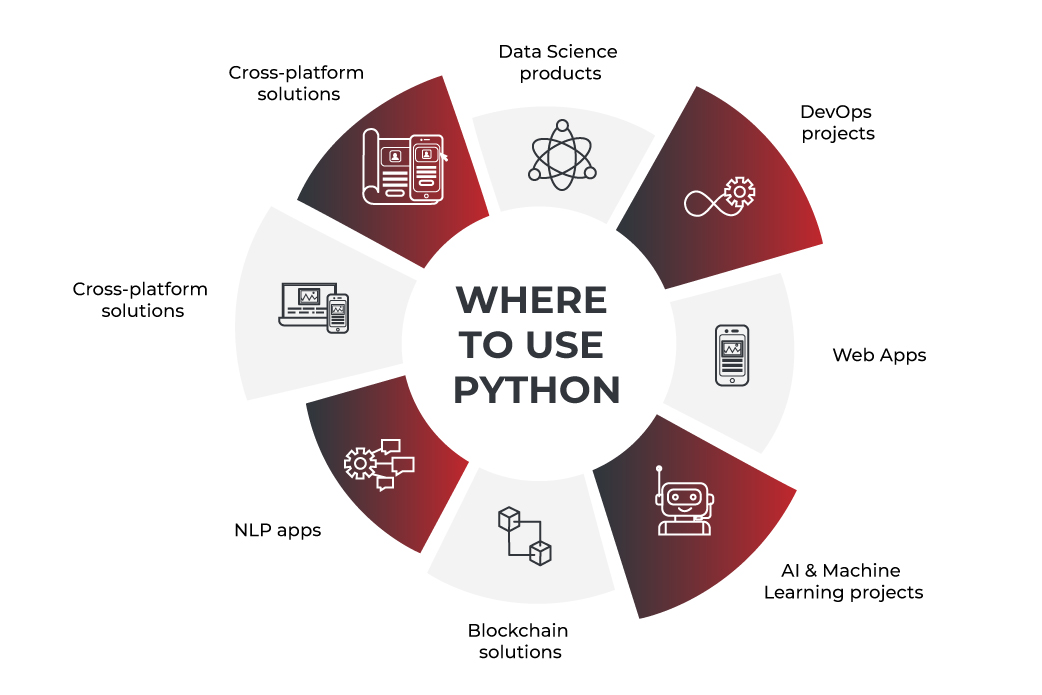
Advantages of Python
This variability is due to Python advantages. We will compare it with other languages below, but for now, we suggest that you clearly state these advantages.
Intuitive syntax
One of the most important benefits of Python. Having relied on an intuitive syntax entirely based on English, Python’s creator Guido van Rossum was right. Today, Python is considered almost the best language for beginners, while having great prospects for the future. Python’s syntax is straightforward and relatively simple, which allows programmers to create projects faster and speed up the time-to-market of products.
Extensive toolkit
The second biggest advantage of Python, after its simplicity, is considered to be a large number of ready-made solutions and tools. Libraries and frameworks that are sharpened for special tasks, such as NumPy for Machine Learning, are particularly influential among Python developers. Closing this point, we must say that Python’s versatility is achieved precisely due to this advantage.
Fast time-to-market
This advantage, thanks to which some explain why python is the best, is achieved due to the combination of several others. So, the simplicity of Python’s syntax, the fact that it is interpreted and does not require compilation, which means it can be run on any platform and, finally, the extensive toolkit, allow us to say that using Python you can achieve a faster time-to-market. Python’s modular architecture and OOP nature also play an important role in this issue.
Vast community
As one of the longest-serving languages, Python boasts a large and active community. More importantly, over the years of its existence, Python has not only not lost its fans but is constantly gaining new ones, taking first places in popularity (most recently in 2020) among developers. An active community is constantly working on the creation of new libraries and tools for Python and is always ready to help in solving any problem.
Portability
Initially, Python was created as a portable language in response to the problems faced by other languages in the early 90s. The interpreted code and modular nature of Python allow the code to run on any modern OS without any adjustments.
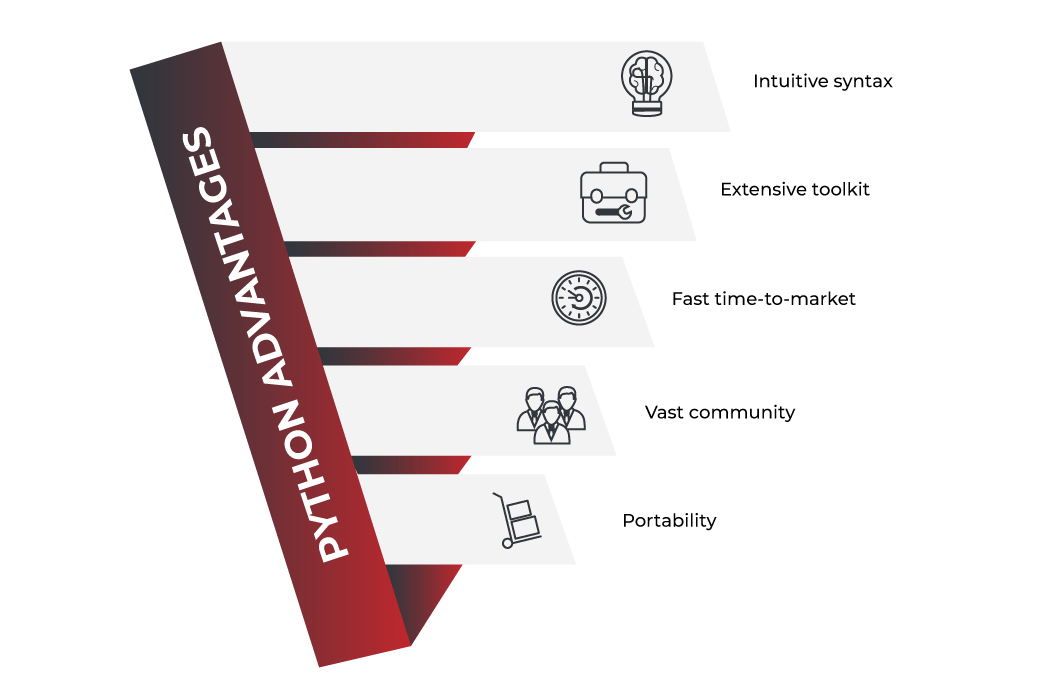
Python vs other languages
Well, it’s time to compare Python with other well-known programming languages, which are often named in the rank of its main competitors. It should be said right away that we do not define the best of the best here, but only compare. So if you were looking for an answer to the question of why Python is better than other languages, then this is not the right article.
For convenience, we have drawn up the main comparative metrics in the form of tables.
Python or Java
We start by looking at the advantages of Python over Java, which is considered the main competitor to our chosen language. Both languages are versatile and very popular among developers. At the same time, while Java is considered the best option for web solutions of any complexity, the purpose of Python is vaguer. The main difference between Python and Java is that Java is the main tool for creating mobile applications for the Android OS, while Python and mobile development are not always a good combination. It is necessary to compare python vs java performance only on specific examples of projects. So if you were looking for an answer to the question of why python is better than java, then this is not the right article.
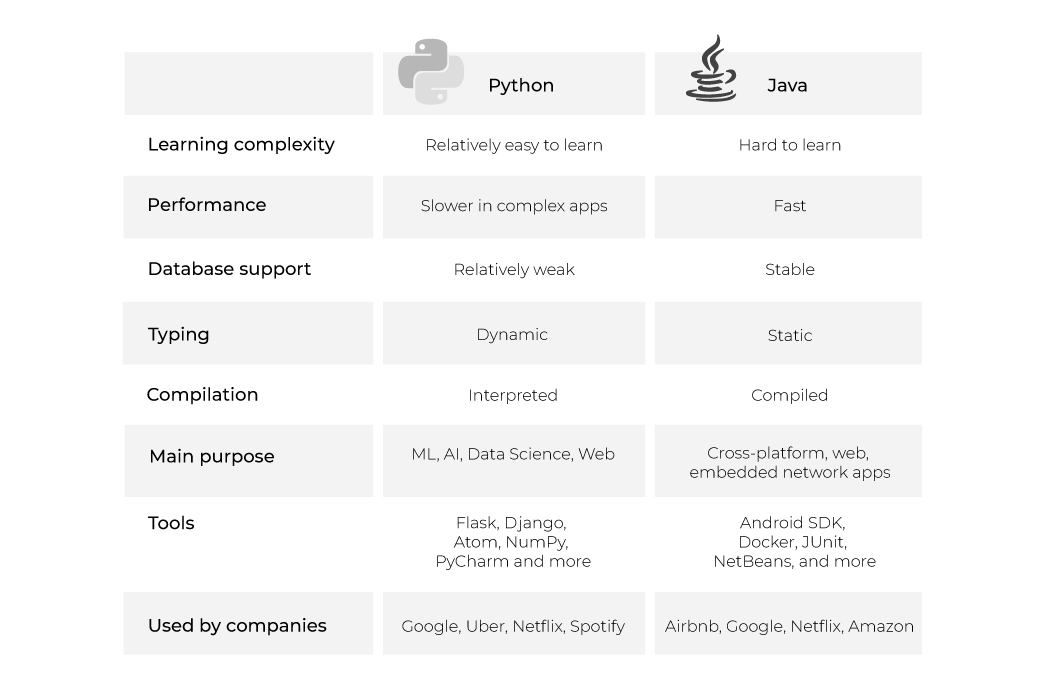
C# vs Python
C# and Python are very similar languages in many ways, although the first, developed by Microsoft, is specially tailored for creating applications for Windows (using the most popular .NET framework). Also, both languages can be called relatively easy to learn in terms of the syntax used, although here Python still enjoys greater success among developers. By providing well-structured code and adopting the OOP paradigm, both languages are in high demand.
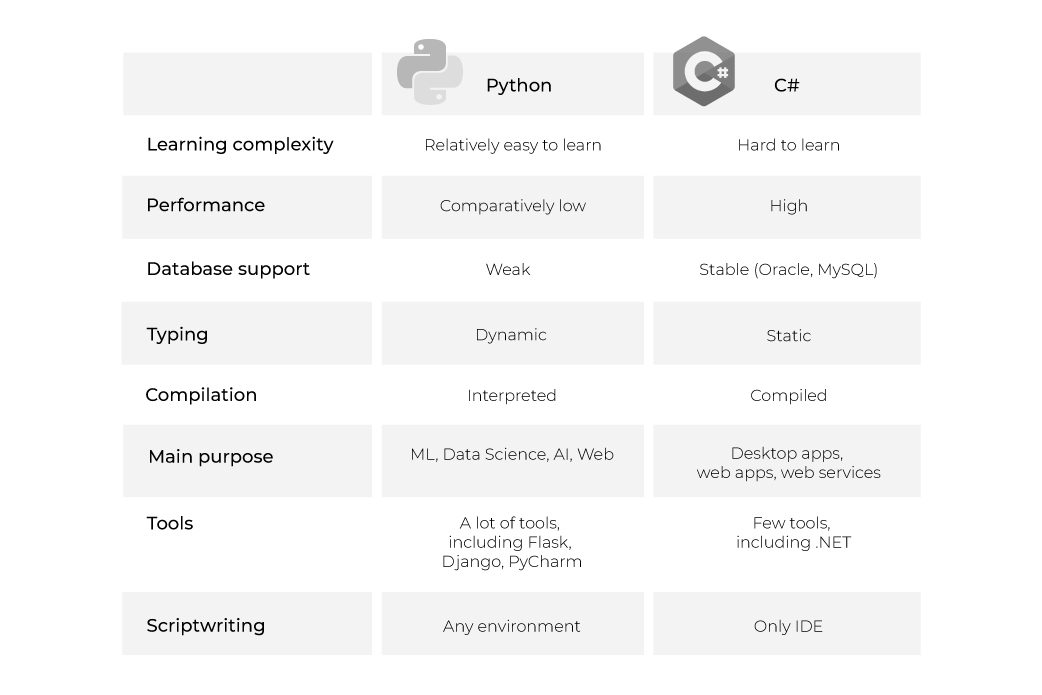
Python vs PHP performance
Both languages have a lot in common. So, both Python and PHP are more tailored for the development of the back-end part of web applications. Both languages adhere to the OOP paradigm and are interpreted. However, there is an opinion among developers that the object orientation of PHP is more chaotic. Like Python, PHP boasts powerful web development tools like Symfony and Lavarel. Nevertheless, Python toolkit still remains one of the most extensive and versatile in the world, and therefore it makes no sense to compare them in this matter. The main difference between PHP and Python is that PHP syntax is in many ways inferior to Python’s in terms of ease of use and proofreading. All this led to an obvious trend towards the transition of PHP developers to Python.
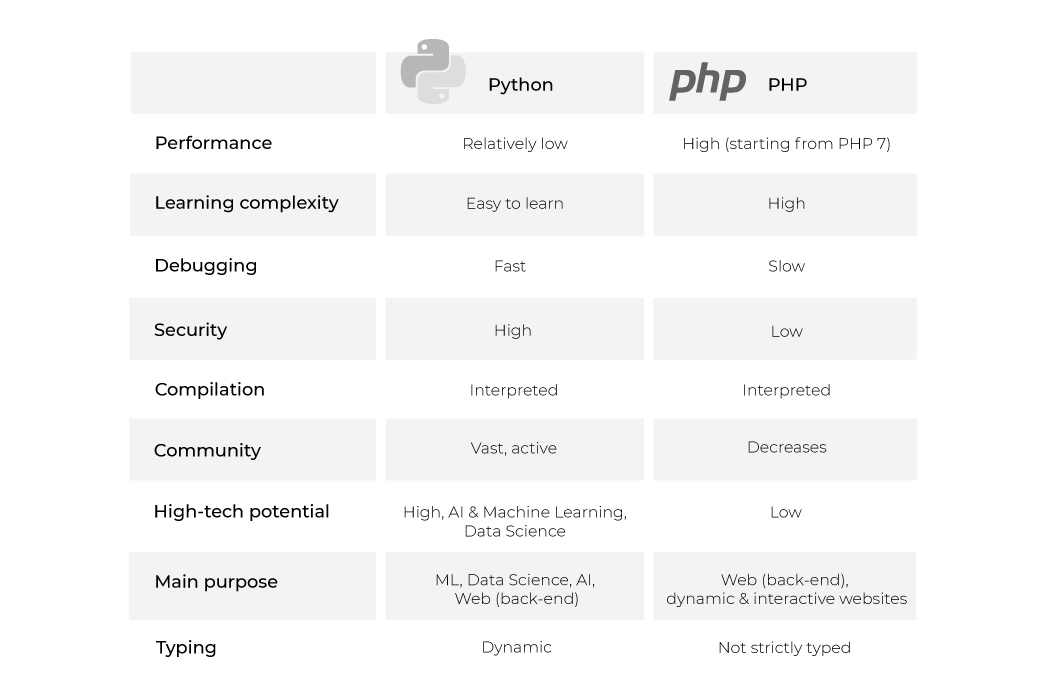
Reasons for Python popularity
Obviously, the popularity of Python among developers and product owners is due to the advantages that this language provides. However, Python advantages and disadvantages are not the only reasons for its relevance. In many ways, this popularity is due to the fact that Python comes in handy more than ever if we take into account modern trends.
The incredible growth in demand for Internet of Things solutions will not slow down anytime soon. And although many continue to defend the opinion that Java is the best technology in this segment, Python still does not trail far behind. The functionality of the language allows developers to combine a large number of devices, sensors, and robots with each other and provide an uninterrupted data flow between them. And the speed with which Python software can be created often outweighs all the advantages of Java in the eyes of the product owners.
In addition to IoT, modern trends can be described literally in just a few words – Artificial Intelligence, Machine Learning, and Data Science. All three segments are in increasing demand and there is no doubt that the future belongs to AI- and Machine Learning-based solutions. And although there is R – the language that serves to create such solutions, more and more people are leaning towards a more versatile and faster Python. Not the least reason for the popularity of Python among AI and ML projects is also a large number of ready-made solutions and libraries specially designed for such tasks (TensorFlow, SciPy, Pandas, NumPy).
At the end of this section, we would like to summarize by saying that the advantages are of course very important, but how much the programming language meets modern needs in the technical and business communities is even more important.
Disadvantages of Python
Despite all the benefits that Python brings, there is a fly in the ointment. Python is not perfect, like any other technology or programming language. And the main complaint that exists among developers is speed.
So, why Python is slow? One of the reasons for the low speed is the interpretation of the Python code on the runtime, while modern smart compilers can get rid of repetitive operations.
In addition, Python’s dynamically typed nature requests the declaration of all variables. This, in turn, forces the computer device to spend more time reading and processing such code.
However, the Python community is actively addressing these issues, and implementing solutions such as PyPy, PyChecker, and Jython will significantly increase performance and speed.
To Sum up
In the end, we would like to say that the reasons for the popularity and versatility of Python are objective and there are no symptoms that something will change in the near future. The variability that Python offers, combined with how this language meets modern trends with the introduction of high technology, provides Python with a confident status as one of the most useful programming languages for both developers and business owners.
Of course, Python has its drawbacks and there are many scenarios when it is better to give your preference to another technology. Nevertheless, Python has been confidently holding leadership positions for many years and the upcoming trends suggest that this will not change.
Looking for Python developers?
The demand for Python and the relative ease of learning determines the annual growth of Python developers. We at CodeIT adhere to a policy of careful selection of specialists through our unique trainee program, which allows us to select only the most worthy developers to be invited on board. Under the leadership of our Python experts, several teams have been created and they’re ready to get involved in a project of any complexity and focus, including AI, ML, and Data Science challenges.
FAQ
In fact, this is not entirely true. Python does have a number of advantages over other languages. First of all, with its clear and simple syntax and a large number of specialized libraries. Nevertheless, each language is worthy of attention, and the choice in favor of Python in comparison with, for example, Java, depends solely on the resources, goals, and objectives that the business faces.
The reason for this is the intuitive English-based syntax, which makes it easier to work with large amounts of data, as well as the presence of specialized libraries specially sharpened for Machine Learning tasks, such as NumPy, SciPy, TensorFlow, PyTorch.
Python is considered relatively slow and only for certain tasks. Small programs work equally quickly in Python, Java, or other languages. When it comes to complex programs, Python really demonstrates less speed, due to the fact that its interpreted code is read on the run without the compiler working. This adds versatility to the Python code but slows it down. However, this difference in speed is hardly noticeable to the average user and the Python community is constantly working to overcome this problem.
Among the main directions, Python is used to create Machine Learning, AI, and Data Science projects. In addition, Python is often used for web development (primarily back-end) and data analysis. Experts can also use Python to create cross-platform and desktop applications and even games. The versatility of Python allows you to use this language in almost any direction, it all depends on the details of the upcoming work.
Build your ideal
software today


